 W
WThe Model 1872 revolver was the service sidearm of the Swiss Army. It was later refined to the Model 1872/78 revolver. Approximately 600 were manufactured in Belgium by Pirlot Frères.
 W
WThe Beaumont–Adams revolver is a black powder, double-action, percussion revolver. Originally adopted by the British Army in .442 calibre in 1856, it was replaced in British service in 1880 by the .476 calibre Enfield Mk I revolver.
 W
WThe Bodeo Model 1889 was an Italian revolver named after the head of the Italian firearm commission, Carlo Bodeo. It was produced by a wide variety of manufacturers between 1889 and 1931 in both Spain and Italy. The Bodeo was employed by the Royal Italian Army in World War I, the Interwar Italian colonial wars, and World War II. The Bodeo comes in two distinct varieties with only superficial weapons differences.
 W
WThe Colt Revolving Belt Pistol or Navy Pistol, sometimes erroneously referred to as "Colt Revolving Belt Pistol of Naval Caliber" or "of Navy Caliber", is a cap and ball revolver that was designed by Samuel Colt between 1847 and 1850. Colt first referred to this Revolver as the Ranger Size model, and then Revolving Belt, but the designation "Navy" quickly took over.
 W
WThe Colt Army Model 1860 is a cap & ball .44-caliber single-action revolver used during the American Civil War made by Colt's Manufacturing Company. It was used as a side arm by cavalry, infantry, artillery troops, and naval forces.
 W
WThe Colt Model 1848 Percussion Army Revolver is a .44 caliber revolver designed by Samuel Colt for the U.S. Army's Regiment of Mounted Rifles. The revolver was also issued to the Army's "Dragoon" Regiments. This revolver was designed as a solution to numerous problems encountered with the Colt Walker. Although it was introduced after the Mexican–American War, it became popular among civilians during the 1850s and 1860s, and was also used during the American Civil War.
 W
WThe Colt Model 1861 Navy cap & ball .36-caliber revolver was a six-shot, single-action percussion weapon produced by Colt's Manufacturing Company from 1861 until 1873. It incorporated the "creeping" or ratchet loading lever and round barrel of the .44-caliber Army Model of 1860 but had a barrel one half inch shorter, at 7.5 inches. Total production was 38,000 revolvers.
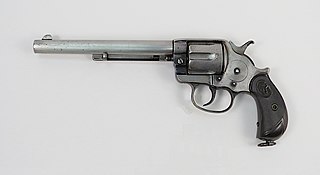 W
WThe Colt M1878 is a double-action revolver that was manufactured by Colt's Manufacturing Company from 1878 to 1907. It is often referred to as the "Frontier" or the "Double Action Army" revolver. A total of 51,210 Model 1878 revolvers were manufactured from 1878 to 1907, including 4,600 for the US Ordnance Department. These are known as the "Philippine" or "Alaskan" models.
 W
WThe Colt M1892 Navy and Army was the first general issue double-action revolver with a swing out cylinder used by the U.S. military.
 W
WThe Colt New Service is a large frame, large caliber, double-action revolver made by Colt from 1898 until 1941. Made in various calibers, the .45 Colt version with a 5½" barrel, was adopted by the U.S. Armed Forces as the Model 1909.
 W
WThe Colt Official Police is a medium frame, double-action revolver with a six-round cylinder, primarily chambered for the .38 Special cartridge, and manufactured by the Colt's Manufacturing Company. Released in 1908 as the Colt Army Special, the revolver was renamed the "Colt's Official Police" in 1927 in order to better market to law enforcement agencies. It became one of the best selling police firearms of all time, eventually in the 1950s coming to exemplify typical law enforcement officer weaponry. The Official Police was also used by various U.S. and allied military forces during World War II.
 W
WThe Colt Single Action Army, also known as the Single Action Army, SAA, Model P, Peacemaker and M1873, is a single-action hand gun with a revolving cylinder holding six metallic cartridges. It was designed for the U.S. government service revolver trials of 1872 by Colt's Patent Firearms Manufacturing Company—today's Colt's Manufacturing Company—and was adopted as the standard military service revolver until 1892.
 W
WThe Enfield No. 2 was a British top-break revolver using the .38 S&W round manufactured from 1930 to 1957. It was the standard British/Commonwealth sidearm in the Second World War, alongside the Webley Mk IV and Smith & Wesson Victory Model revolvers chambered in the same calibre.
 W
WThe Enfield Revolver was a self-extracting British handgun designed and manufactured at the government-owned Royal Small Arms Factory in Enfield, initially in the .476 calibre.
 W
WThe Frontier Bulldog, Western Bulldog, or American Bulldog is a 5-shot, .44 S&W American, double action, 2+1⁄2-inch barrel snubnosed revolver made by the Belgian firm J.B. Rongé & Sons of Liège, and primarily sold in the United States, from late 1870s to 1914, through the Sears-Roebuck and Montgomery Ward mail-order catalogs. The base price was US$3.80, compared to $12 for a Smith & Wesson Model 3 Double Action in the same calibre. It is a copy of the Philip Webley & Son of Birmingham British Bull Dog revolver.
 W
WThe Gasser M1870 was a revolver chambered for 11.3×36mmR and was adopted by the Austro-Hungarian Cavalry in 1870. It was an open-frame model, with the barrel unit attached to the frame by a screw beneath the cylinder arbor. The arbor pin was screwed into the barrel unit and fitted into a recess in the standing breech. The cylinder was gate-loaded from the right side, and a rod ejector was carried beneath the barrel. A unique safety bar will usually be found on the right of the frame, below the cylinder. This carries pins which pass through holes in the frame to engage the lock mechanism. Slightly retracting the hammer allows one of these pins to move inward, preventing the hammer moving forward again when released. The pistol can thereafter be carried safely when loaded. Pressure on the trigger withdraws the pin from the path of the hammer before firing. The M1870 Gasser became the Austro-Hungarian cavalry revolver. It chambered a long 11.25mm centerfire cartridge which had earlier been used in Fruwirth carbines.
 W
WThe LeMat revolver was a .42 or .36 caliber cap & ball black powder revolver invented by Jean Alexandre LeMat of New Orleans, which featured an unusual secondary 20 gauge smooth-bore barrel capable of firing buckshot. It saw service with the armed forces of the Confederate States of America during the American Civil War of 1861–65 and the Army of the Government of National Defense during the Franco-Prussian War.
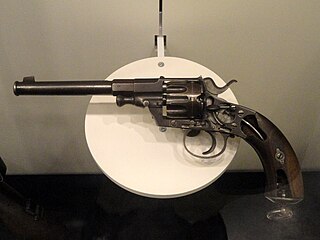 W
WThe M1879 Reichsrevolver, or Reichs-Commissions-Revolver Modell 1879 and 1883, were service revolvers used by the German Army from 1879 to 1908, when it was superseded by the Luger.
 W
WThe M1917 Revolvers were six-shot, .45 ACP, large frame revolvers adopted by the United States Military in 1917, to supplement the standard M1911 pistol during World War I. There were two variations of the M1917, one made by Colt and the other by Smith & Wesson. They used moon-clips to hold the cartridges in position, facilitate reloading, and to aid in extraction since revolvers had been designed to eject rimmed cartridges and .45 ACP rounds were rimless for use with the magazine-fed M1911. After World War I, they gained a strong following among civilian shooters. A commercial rimmed cartridge, the .45 Auto Rim, was also developed, so M1917 revolvers could eject cartridge cases without using moon-clips.
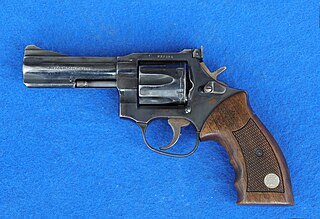 W
WThe Manurhin MR73 is a French-manufactured, high-end double-action/single-action revolver primarily chambered in .38 Special and .357 Magnum. The MR73 is manufactured by Manurhin and is available in 2.5", 2.75", 3", 4", 4.25”, 5.25", 5.75", 6" and 8" barrel lengths.
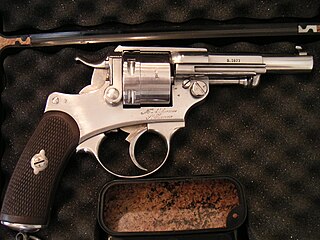 W
WThe service revolver model 1873 Chamelot-Delvigne was the first double-action revolver used by the French Army. It was produced by Manufacture d'armes de Saint-Étienne from 1873 to 1887 in about 337,000 copies. Although replaced by the Modele 1892 revolver, it was nevertheless widely used during the First World War, and issued to reserve units in 1940. The Resistance made widespread use of it during the Occupation.
 W
WThe Mauser C78 - also known as M78 Oberndorf - is a single-action revolver manufactured by Mauser company in Oberndorf am Neckar during the late 19th century. It was the first German revolver to be mass-produced for modern center-fire cartridges. It was also called the "Zig-Zag" in reference to the design of the six-round zig-zag-grooved cylinder and was chambered in calibers from 6 mm to 11 mm.
 W
WThe Model 1892 revolver is a French service revolver produced by Manufacture d'armes de Saint-Étienne as a replacement for the MAS 1873 revolver. It was the standard issue sidearm for officers in the French military during the First World War.
 W
WThe Nagant M1895 Revolver is a seven-shot, gas-seal revolver designed and produced by Belgian industrialist Léon Nagant for the Russian Empire.
 W
WRewolwer Nagant wz. 30 and wz. 32 were two Polish derivatives of the Nagant M1895 revolver. They were almost identical to the Soviet variants with only minor differences in weight, length and sights design.
 W
WThe Rast & Gasser Model 1898 was a service revolver used by the Austro-Hungarian Army during World War I and various armies in World War II.
 W
WThe Remington-Beals Model Revolvers along with subsequent models and variations were percussion revolvers manufactured by Eliphalet Remington & Sons in .31 (Pocket) .36 (Navy) or .44 (Army) caliber, used during the American Civil War, and was the beginning of a successful line of medium and large frame pistols. They are commonly, though inaccurately, referred to as the Model 1858 due to the patent markings on its New Model barrels, "PATENTED SEPT. 14, 1858/E. REMINGTON & SONS, ILION, NEW YORK, U.S.A./NEW MODEL."; although wide scale production did not start until 1861.
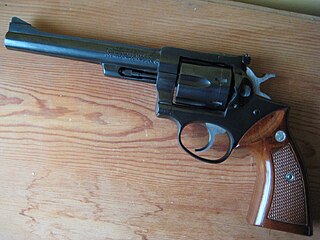 W
WThe Ruger Security-Six and its variants, the Service-Six and Speed-Six are a product line of double-action revolvers introduced in 1972 and manufactured until 1988 by Sturm, Ruger & Company. These revolvers were marketed to law enforcement duty issue, military, and civilian self-defense markets.
 W
WThe Smith & Wesson Model 10, previously known as the Smith & Wesson .38 Hand Ejector Model of 1899, the Smith & Wesson Military & Police or the Smith & Wesson Victory Model, is a K-frame revolver of worldwide popularity. In production since 1899, the Model 10 is a six-shot, .38 Special, double-action revolver with fixed sights. Over its long production run it has been available with barrel lengths of 2 in (51 mm), 2.5 in (64 mm), 3 in (76 mm), 4 in (100 mm), 5 in (130 mm), and 6 in (150 mm). Barrels of 2.5 inches (64 mm) are also known to have been made for special contracts. Some 6,000,000 of the type have been produced over the years, making it the most popular handgun of the 20th century.
 W
WThe Smith & Wesson K-38 Combat Masterpiece, Revolver Model 15 is a six-shot double-action revolver, with adjustable open sights, built on the medium-size "K" frame. It is chambered for the .38 Special cartridge and is fitted with a 4-inch (100 mm) barrel, though additional barrel options have been offered at various times during its production. Originally known as the "K-38 Combat Masterpiece", it was renamed the Model 15 in 1957 when all Smith & Wesson revolvers were given numerical model numbers. It is a shorter barrel version of the Smith & Wesson Model 14 Target Masterpiece and essentially an adjustable-sight version of the seminal Smith & Wesson Model 10 revolver with target shooting features. The main production run of the Model 15 was from 1949 to 1999. It was discontinued for approximately a decade until 2011, when a re-tooled version was re-released under S&W's Classics Revolvers line.
 W
WThe Taurus Model 85 is a small-frame revolver manufactured by the Brazilian firearm company Taurus International. In the United States, the guns are marketed for concealed carry and personal protection.
 W
WThe Type 26 or Model 26 "hammerless" revolver was the first modern revolver adopted by the Imperial Japanese Army. It was developed at the Koishikawa Arsenal and is named for its year of adoption in the Japanese dating system. The revolver saw action in conflicts including the Russo-Japanese War, World War I and World War II.
 W
WThe Union automatic revolver was a .32 caliber revolver. It was designed by Charles F. Lefever and manufactured by the Union Firearms Company of Toledo, Ohio.
 W
WThe Webley Revolver was, in various marks, a standard issue service revolver for the armed forces of the United Kingdom, the British Empire and the Commonwealth, from 1887 to 1970.
 W
WThe Webley–Fosbery Self-Cocking Automatic Revolver is an unusual, recoil-operated, automatic revolver designed by Lieutenant Colonel George Vincent Fosbery VC and produced by the Webley & Scott company from 1901 to 1924. The revolver is easily recognisable by the zig-zag grooves on the cylinder.